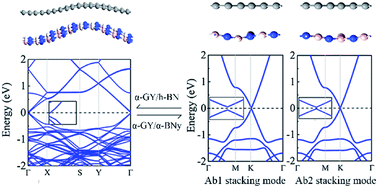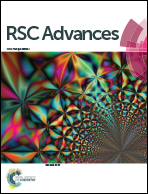Electronic properties of α-graphyne on hexagonal boron nitride and α-BNyne substrates†
Abstract
The upsurge in the research of α-graphyne (α-GY) has occurred due to the existence of a Dirac cone, whereas the absence of band gap impedes its semiconductor applications. Here, the electronic properties of α-GY on hexagonal boron nitride (h-BN) and α-BNyne (α-BNy) monolayers are investigated using first-principles calculations. Through engineering heterostructures, the band gap opening can be achieved and has different responses to the substrate and stacking sequence. Intriguingly, the band gap of α-GY/α-BNy with Ab1 stacking mode is up to 77.5 meV in the HSE06 functional, which is distinctly greater than KBT at room temperature. The characteristic Dirac band of α-GY is preserved on the α-BNy substrate, while it changes into a parabolic band on the h-BN substrate. Additionally, we also find that changing the interlayer distance is an alternative strategy to realize the tunable band gap. Our results show that by selecting a reasonable substrate, the linear band structure and thus the high carrier mobility as well as the distinct band gap opening could coexist in α-GY. These prominent properties are the key quantity for application of α-GY in nanoelectronic devices.



 Please wait while we load your content...
Please wait while we load your content...